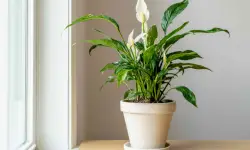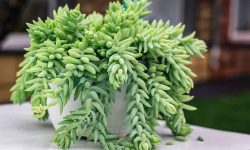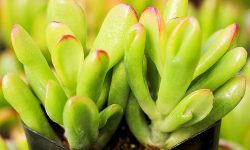The Yellow Christmas Cactus, a vibrant member of the genus Zygocactus, brings a sense of warmth and radiance to any indoor or outdoor space with its beautiful yellow flowers. This plant, known for its unique color and captivating flowers, is loved by plant enthusiasts for its beauty and resilience.
In this guide, we delve into how to care for, propagate, and maintain this exciting plant and provide insights to help you grow it and enjoy its splendor all year round.
About Yellow Christmas Cactus
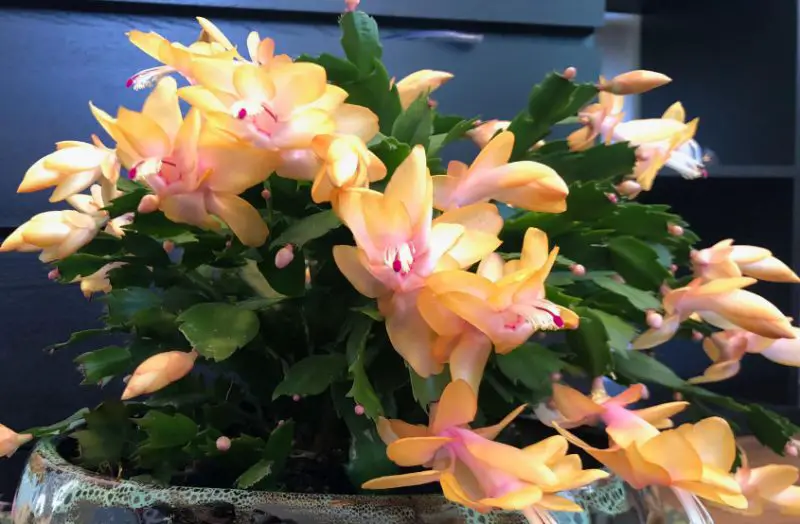
The Yellow Christmas Cactus, also known as the Yellow Decembrists, represents an addition to the world of epiphytic cacti. These unique plants, which have been carefully cultivated, stand out from other members of the zygocactus genus due to their remarkable range of flower colors, ranging from delicate white-yellow hues to vibrant yellow-gold tones. Their flowers, with an average length of 5.5 to 9 cm and a width of 5 to 8 cm, add a burst of color to any environment.
What sets the Yellow Christmas Cactus apart further are its distinctive stem segments. These segments, measuring between 3 to 7 cm in length and 1 to 4.5 cm in width, form the basis of its lush, green shoots. These segments are marked by pronounced notches, lending the plant an unmistakable appearance. Moreover, these segments often grow vertically, adding an elegant touch to their overall presentation.
Intriguingly, the Yellow Christmas Cactus thrives in conditions that mimic its natural habitat, favoring environments that offer ample humidity and indirect sunlight. With proper care, these plants can flourish, offering their owners a delightful display of unique blooms year after year.
History of formation of Yellow Christmas Cactus
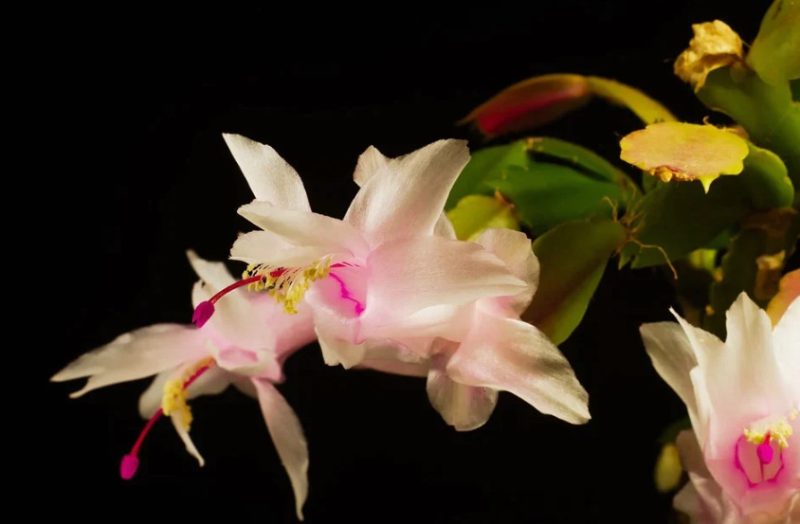
The journey to create the Yellow Christmas Cactus is a testament to the patience, dedication, and ingenuity of plant breeders worldwide. Unlike its counterparts in natural habitats, which boast hues of pink, red, orange, and white, the yellow petals of this gorgeous plant were not typical. In the lush tropical forests where its ancestors thrived, only colors conducive to attracting long-billed hummingbirds, such as red, were prevalent.
The quest to introduce yellow into the Decembrist lineage required the collaborative efforts of breeders spanning continents, including Australia, Japan, the USA, and Denmark. This endeavor, spanning many years, underscores the complexities inherent in hybridization and the meticulous selection process necessary to achieve the desired traits.
The breakthrough came with the introduction of the first yellow-flowered Decembrist variety, “Gold Charm,” meticulously bred by American horticulturist R.L. Kobia in the 1980s. However, the journey to bring “Gold Charm” to fruition was no easy feat, stretching over a remarkable 15 years.
Kobia’s methodical approach began with the selection of 50,000 plant seeds from varieties displaying orange flowers, where the elusive yellow component held sway over red and pink. From this extensive pool, only a single bush bearing yellow buds emerged, albeit weak and fragile, posing challenges for further propagation.
Undeterred by setbacks, Kobia ingeniously crossed this solitary yellow-budded specimen with a robust white Schlumbergera cactus, yielding approximately 200 seeds. From this cross, 150 resilient bushes emerged, each holding the promise of botanical innovation. Among them, one stood out as the “ancestor” of the coveted yellow-flowered zygocactus, marking a triumphant culmination of years of meticulous breeding efforts.
Different Types of Yellow Christmas Cactus
Golden Cream Christmas Cactus
The Golden Cream Christmas Cactus stands as a stunning creation crafted by the skilled hands of Australian breeders. This variety, distinguished by its captivating coloration, offers a mesmerizing display that seamlessly transitions from a delicate pale yellow hue to a luxurious and radiant yellow-gold tint.
Each bloom exudes a sense of warmth and elegance, casting a luminous glow wherever it blooms. Soft pink stamens, nestled within the heart of the blossom, provide a subtle contrast and add a touch of gentle beauty to the overall composition.
Gold Charm Christmas Cactus
The Gold Charm Christmas cactus stands out as a pioneer variety in the field of zygotic cacti. It has bright yellow flowers that reach an impressive size of 7-8 cm. What sets this variety apart is not only the striking color but also the delicate yellow-green tones that give each flower a unique beauty.
In addition, Gold Charm exhibits vibrant and vigorous growth, with bright green buds decorated with large segments. This lush foliage acts as a verdant backdrop, accentuating the brilliance of the flowers.
Golden Charm thrives with regular watering and feeding. With proper care and attention, this remarkable variety promises to grace any space with its radiant presence.
Christmas Flame, Gold Fantasy
The Christmas Flame and Gold Fantasy varieties emerge as stunning descendants of the Decembrist mutation known as “Gold Charm,” sharing similarities in their bud shape and overall plant structure. However, it is in the vibrant hues of their flowers that these varieties truly shine.
Distinctive in appearance, the buds of the Christmas Flame variety initially showcase a mesmerizing red-violet color. Yet, as they unfurl, a remarkable transformation takes place, revealing petals of deep yellow with a striking orange edging. The gradual transition from rich red-violet to fiery yellow-orange mirrors the flickering flames of a candle, evoking a sense of warmth and intrigue.
It is this resemblance to a dancing flame that justifies the variety’s evocative name, “Christmas Flame,” a title officially patented in the USA. However, across the oceans in Australia, this same enchanting zygocactus is known by another name: “Gold Fantasy.”
Cambridge
Cambridge emerges as a variety born from the union of “Gold Charm” and “Christmas Flame,” two esteemed predecessors renowned for their exceptional beauty. Inheriting the best of both parents, Cambridge showcases bright yellow flowers adorned with a subtle yet alluring salmon tint at their centers. This delicate interplay of colors creates a harmonious symphony of hues, captivating all who behold its blooms.
Notably, Cambridge exhibits a distinctive vertical growth pattern, adding an elegant touch to its overall presentation. With flowers boasting lengths ranging from 6.5 to 8.5 cm and widths spanning 6 to 8 cm, this variety commands attention with its impressive size and graceful form.
Golden Orpheus
Introduced as a novelty in 2017 by Danish breeders, the Golden Orpheus impresses with its uniqueness and special features. One of its most striking features is the wavy shape of its petals, creating a mesmerizing beauty for each flower.
The petals themselves have their own range of colors, with a light yellow, almost white color in the center transitioning seamlessly into a deep yellow at the petal tips. Adding to its appeal, delicate strokes of pale pink color adorn the entire bud.
Yellow Christmas Cactus Care Guide
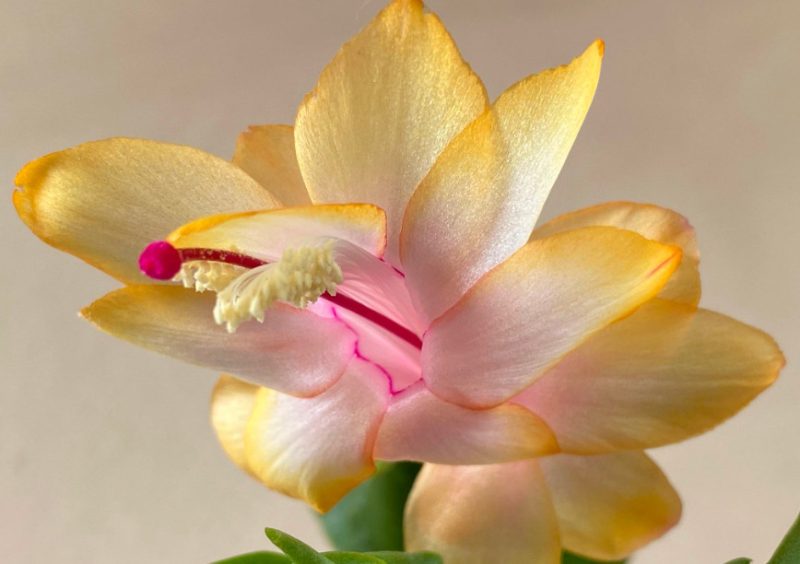
Caring for a Yellow Christmas Cactus, regardless of its type or variety, requires attention to detail and a gentle touch. However, during the flowering period, special care is needed to ensure the plant thrives and maintains its vibrant blooms.
Water
One of the most crucial aspects of caring for a Yellow Christmas Cactus during flowering is watering. As the plant expends significant energy on producing and maintaining its blossoms, it’s essential to keep the soil consistently moist. Regular watering is vital, with the frequency determined by the dryness of the top layer of soil. Waiting until the surface dries out before watering helps prevent bud drop, a common issue during this period.
Fertilizer
In addition to proper watering, providing adequate nutrition is essential for supporting the plant’s flowering process. During this time, fertilizing with phosphorus and potassium-rich fertilizers is recommended to bolster flower production and longevity. However, it’s crucial to avoid nitrogen-heavy fertilizers, as they can promote excessive foliage growth at the expense of flowers.
Light
During the winter blooming months, ensure that Christmas cacti receive between 4 to 6 hours of diffused light. While the plant thrives in both sunlight and shade, it’s essential to maintain a balance and avoid excessive exposure to either. Ideally, provide holiday cacti with partial shade or diffused light, although they can adapt to varying conditions. If exposing them to full sunlight, reserve it for the winter months, as excessive sunlight during spring and summer may lead to the plant becoming pale and yellow.
Soil
You can plant your Christmas cactus in a mixture of loamy soil, sandy soil, perlite mix, cactus mix, or general-purpose potting soil. The type of soil isn’t critical as the Christmas cactus is adaptable to various soil conditions and naturally grows as an epiphyte in its native habitat. However, for best results, aim for a pH level between 5.5 and 6.2; adding peat moss can be beneficial to create a more acidic environment conducive to optimal growth.
Temperature and Humidity
For optimal growth from April to September, the Christmas cactus thrives in warm temperatures ranging between 70°F and 80°F. However, once its buds have formed, it necessitates cooler nighttime temperatures, ideally between 55°F and 65°F, along with a minimum of 13 hours of darkness to initiate flowering. To ensure its well-being, keep the plant away from heating vents, frequently-opened doors, or drafty windows as it is sensitive to sudden temperature changes, which can lead to bud or flower drop if conditions are unfavorable.
Maintaining adequate humidity is crucial, particularly when cultivating the Christmas cactus indoors, where heated environments often result in dry air during the winter months. To enhance humidity levels, consider either misting the plant regularly or placing a pebble tray filled with water beneath the pot.
Fertilizer
During the early spring and summer months, provide your Christmas cactus with a half-strength, diluted water-soluble balanced fertilizer once a month. Cease fertilization once flower buds begin to form, typically in late summer or early fall. Resume monthly feedings after the plant has finished blooming.
Diseases And Pests Of Yellow Christmas Cactus
Yellow Christmas Cactus, including those with yellow flowers, are susceptible to the same diseases and pests as other varieties of the Decembrist. This means they require similar attention and care to maintain their health and vitality.
The main cause of diseases in yellow-flowered plants often results from improperly organized care, leading to symptoms such as leaf discoloration or wilting.
Specific causes include sunburn, nutrient imbalances, excessive watering, and exposure to cold temperatures. Managing these issues involves revising the care regimen.
Adjusting sunlight exposure, ensuring proper watering and fertilization, and addressing fungal infections with appropriate treatments are essential steps. Additionally, vigilance against common pests like spider mites, mealybugs, and scale insects is crucial for preserving the plant’s well-being.
Propagation Methods for Yellow Christmas Cactus
When propagating your Yellow Christmas Cactus, there are several methods to consider, each with its unique advantages. Three popular propagation methods include stem cuttings, leaf cuttings, and division.
For stem cuttings, select a healthy stem and prepare the cutting by removing lower leaves, allowing it to callus before planting. Provide the right conditions and transplant the rooted cutting once it develops roots.
Leaf cuttings involve selecting a healthy leaf, allowing it to callus, and planting it in well-draining soil. After a few weeks, small plantlets should start forming at the base of the leaf.
Division is effective for overcrowded plants. Gently divide the plant into smaller sections, ensuring each has its own stems and roots, then plant them in individual pots. With proper care, each division should grow into a healthy yellow Christmas cactus.




